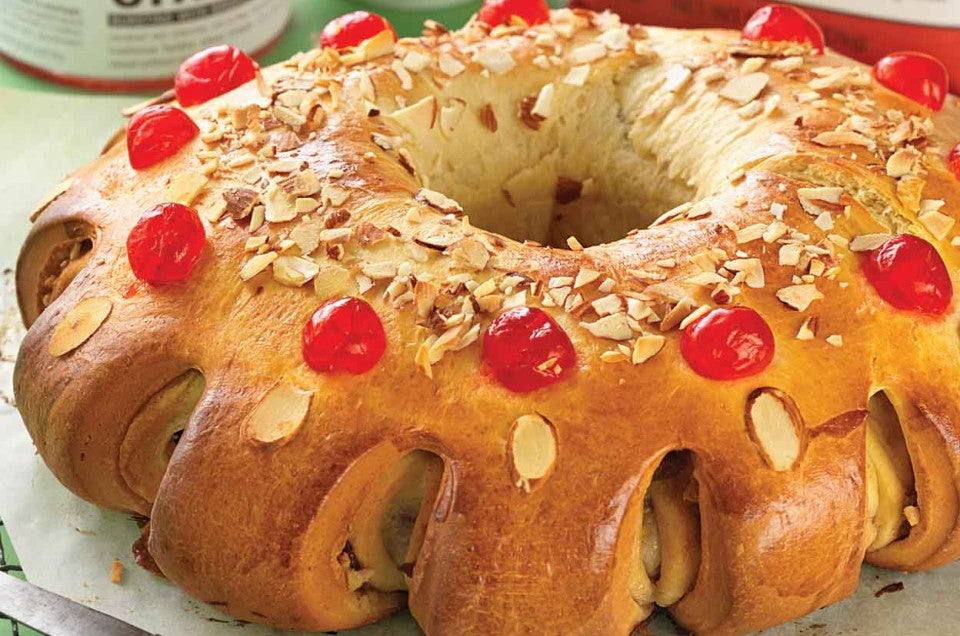


It’s quite possible by now you’ve had enough of Christmas carols. However, the Twelve Days of Christmas begin today, continuing through January 5, when the Twelve Drummers Drumming arrive. The fun, in many parts of the world, is just beginning.
January 6 is the Epiphany, or “Dia de Reyes” (Three King’s Day). Growing up at our house, it meant it was time to take down the Christmas tree, but in most Latin cultures, Dia de Reyes is the day that children get presents from the Magi, not Santa. The night before, children leave their shoes (often decorated with dried or candied fruits) outside, filled with feed for the Kings’ animals and a note. The next day, Gaspar, Melchior and Balthasar will have replaced the hay with gifts.
As with any great tradition, there’s a tasty baked good involved. Sometimes called Three Kings’ Bread, Rosca de Reyes is more than a scrumptious treat. Its shape evokes a crown, and hidden inside is a trinket or small doll that represents the baby Jesus. When the bread is cut and served, whoever finds the trinket in their portion is obligated to host a party on Candlemas Day, February 2.
In Spain, there’s both a trinket and a bean. The finder of the doll is crowned and becomes the king or queen of the banquet. Whoever gets the bean has to pay for next year’s Rosca.
OK, now that the mechanics around the party are in place, shall we make some of this delicious bread? It’s as beautiful as it is tasty.
My first step is going to be to candy some orange peel. You can find a recipe for this in the Spring 2010 issue of The Baking Sheet. I've also put the recipe online. You can certainly use store-bought, but the flavor of what you make fresh is worth the effort, and you can make sure it's the shape and size you want.
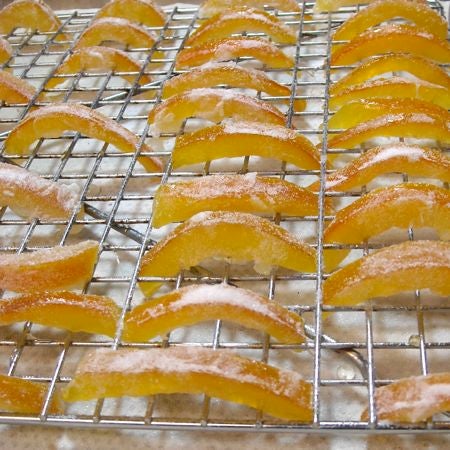
Once the orange peel is drying in its rack to set it into a nice curve, I'm ready to start the dough. Here's the recipe for Three King's Cake (Rosca de Reyes) so you can add it to your recipe stash, or follow along with me.
You can make the dough in a bread machine or your mixer; I did both so you'd have an idea of how it works either way. The technique is the same from after the first rise to the finish.
First, we scald some milk, then pour it over the butter and sugar. This melts the butter and dissolves the sugar.
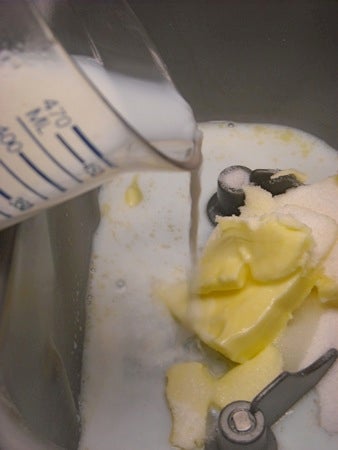
I'll let this mixture cool to lukewarm; while that's going on I'll gather and measure the rest of my ingredients.
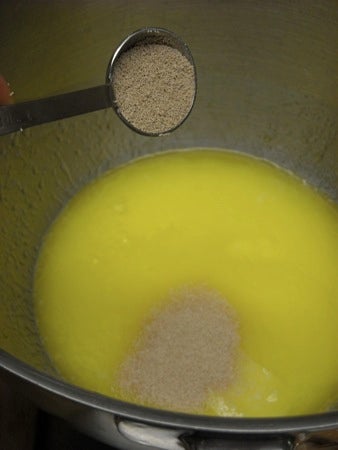
Next, the yeast is added, then the eggs, salt, and flour.
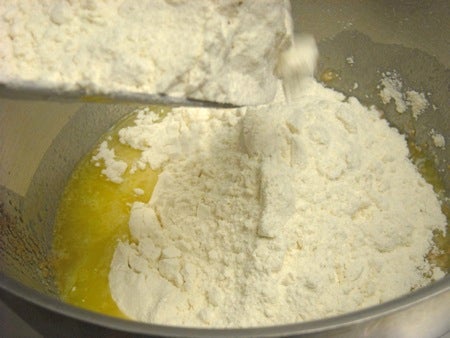
Time to mix this up. I'll start with the paddle. It's going to look pretty raggedy at first.
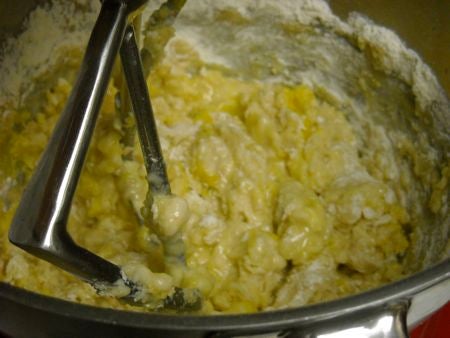
Once the dough starts to form up, it's time to switch to the dough hook. This is also the time to scrape the sides and bottom of the mixing bowl. I am a stickler for this step. It's the difference between "OK" and "Wow!" in the final result of baking.
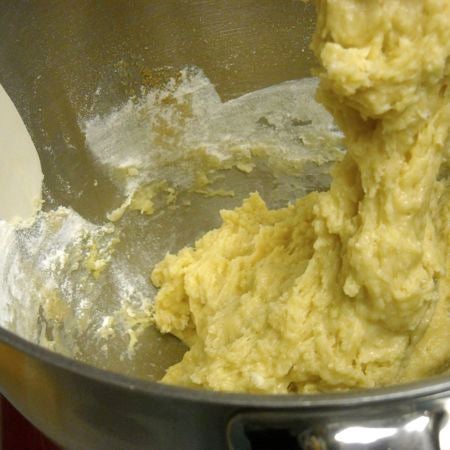
When we write recipes that say "mix and knead the dough", this is the intersection or pivot point between those two instructions.
Once the bowl is scraped and the hook in place, I'll let the mixer run at medium speed for 6 minutes. You don't want to go too fast with this; else the dough gets beat up and the gluten you're trying to develop gets torn. Since this is a sweet dough with butter in it (which will shorten the gluten strands anyhow, making the bread more tender), it's important not to work it too hard. You need the gluten strands to form so they can capture the carbon dioxide from the yeast, and allow the dough to rise nicely.
How's the bread machine batch doing?
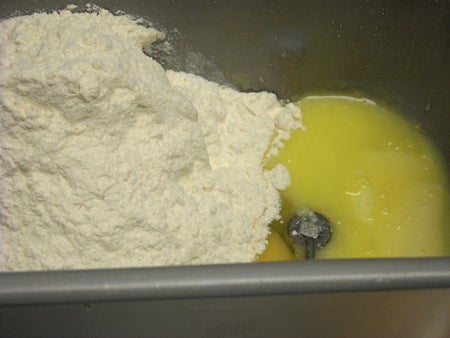
While I was switching to the dough hook and scraping, the machine was very nicely doing its job in the corner. I added the flour, took a peek at the dough about 5 minutes later to make sure no flour was stuck in the corners of the bucket (that scraping thing again), and that was it. The machine took care of the rest. I love the machine.
Back to the mixer. Once the dough is kneaded...
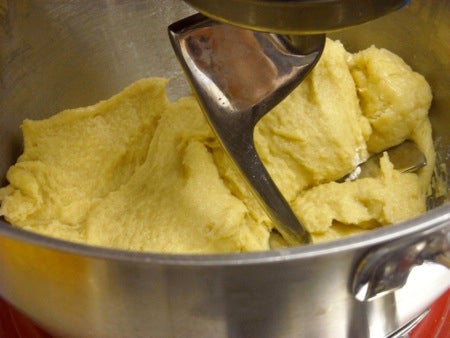
...I put it in a greased measuring cup for its first rise. We find these big bad measuring cups to be extremely handy for this. You can see what's going on with the dough, and the marks tell you where the dough started and when it's doubled. If you need the reminder, you can always put a little piece of tape on the level of the container where the dough started.
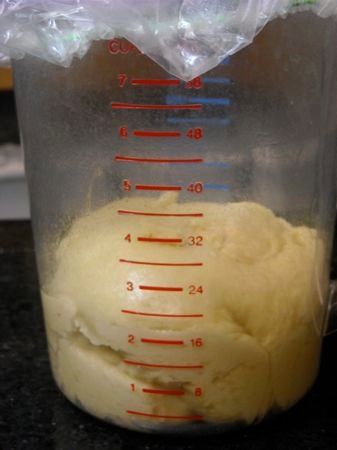
While the dough rises, I'll put the filling ingredients together. You can use any kind of nut you want in the filling, but since I plan to decorate with almonds, I'm going to put chopped almonds in the filling. I usually start with slivered ones, since they give me a head start on the chopping thing.
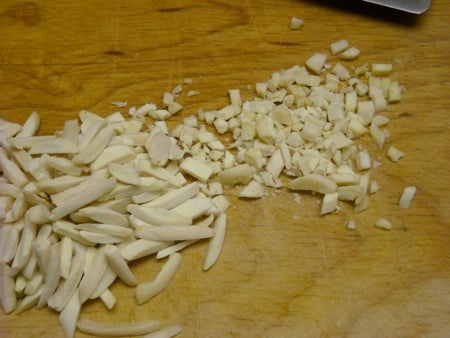
You could pop 'em in the food processor, but I never pass up a chance to give my chef's knife some exercise (also less to wash after). Next step, to toast them lightly. To do that I'll put them in a pie plate (a baking sheet is fine, too. You just want something shallow.)
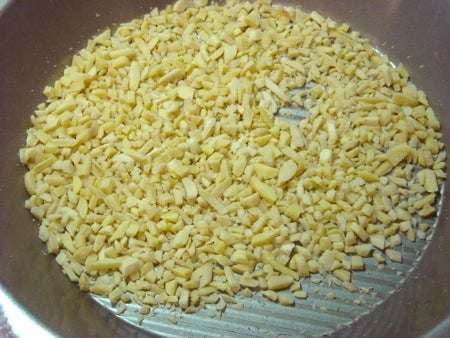
And bake for 10 minutes at 325°F, just until they begin to take on some color.
Small aside here. Nuts are expensive. I've seen pounds and pounds of them go straight to the trash can in restaurants from cooks who think that 400°F to 500°F ovens will save them some time. The high oil content in nuts means that once they start to caramelize, the window of opportunity to catch them at the right point gets smaller, the higher the temperature you use. Something like trying to stop a 200mph Ferrari on a dime with no notice. So be a fuddy duddy and do it once. Correctly. The first time. Low and slow is the way to go. End rant.
Combine the cinnamon, sugar, fruit, and nuts. I got ahead of myself and stirred the melted butter into the fruit instead of using it to brush the dough; either way works, so don't worry yourself on that score.
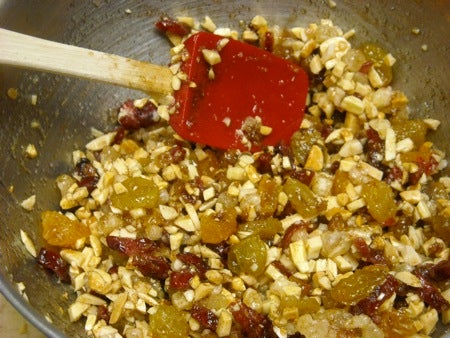
Almost forgot the orange zest...
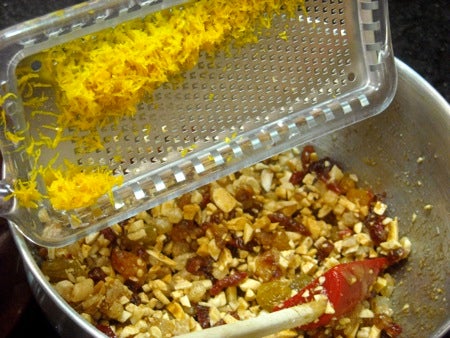
OK, how's the dough doing? Despite it being December, it's pretty warm in the test kitchen these days. We're talking 83 degrees or more most days (we've got all guns [ovens, all 7] blazing). So it doesn't take too long for the dough to double.
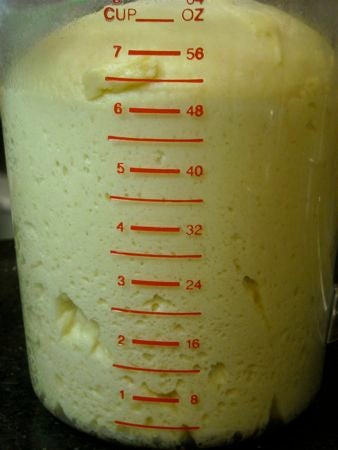
Ready to roll out. I greased the work surface and rolled the dough out into a long rectangle: 20” long by 10”. It's best to roll it partway, let it rest for a few minutes, then roll once more to its final dimensions. That way it shouldn't snap back when you're trying to get it bigger.
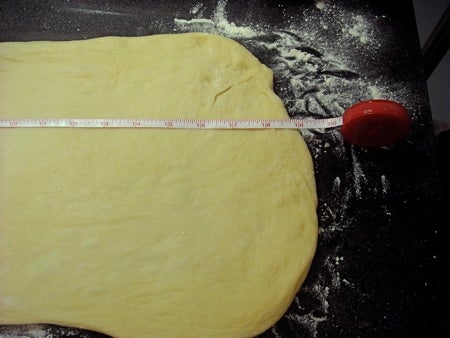
This is the point where I realized, "Oh yeah. Parchment." Easy to remedy, thank goodness.
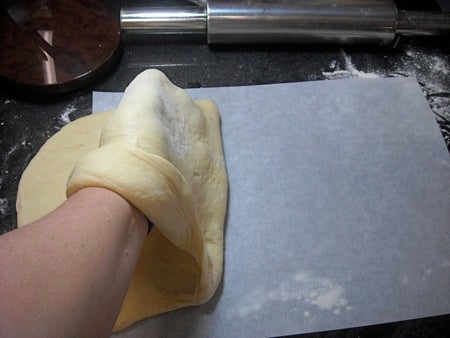
I'll spread the filling over the dough, leaving about half an inch of the long edges uncovered. If you're going to add a doll or a bean (I used a single macadamia nut; I like my inclusions to be edible) to the bread as tradition requires, this is the place to do it. Now roll up the dough (don't pull or wind it too tight; just flop it over on itself).
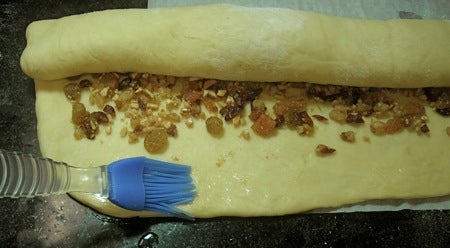
Brush the edge with some beaten egg (I just use egg substitute right out of the carton) and pinch the edge to seal.
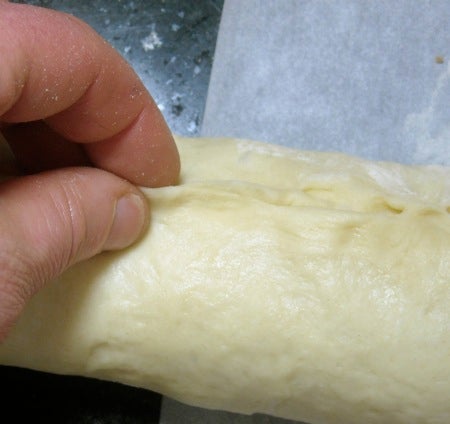
The Rosca is supposed to represent the crown of the king, so the idea is to bake it round. I have a hint to help you make a nice-looking circle. I take a small metal bowl (a ramekin or custard cup will work for this; so would a clean tuna can) and grease the outside. Place that in the center of the parchment, and place the rolled dough around it. This will help the bread keep a nice, neat circle inside as it rises and bakes.
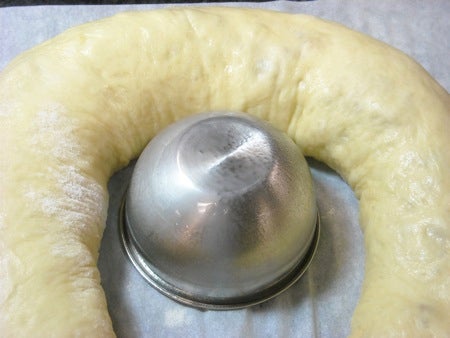
The next step is to complete the circle. Tuck one end inside the other (a little like a snake eating its tail), and pinch the dough together.
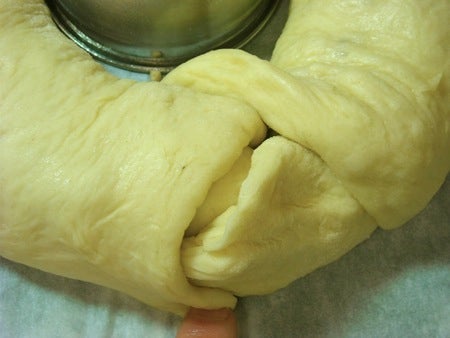
Once this is done, it's time to decorate. Remember the nicely curved slices of orange peel? I'm going to place them around the edges of the bread. Cut shallow slits (I did the four corners of the compass, then one more slice halfway between each cut for 8 in all) in the dough. Brush the cut with more egg...
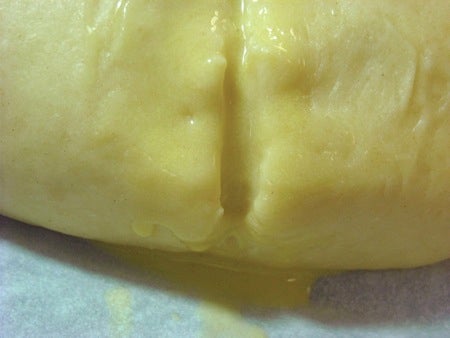
...then place the peel in the cut.
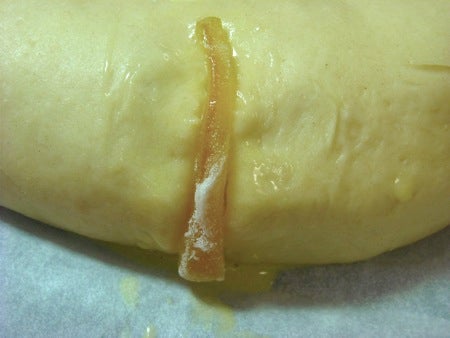
Brush the rest of the dough with egg wash, and place halved candied cherries in each of the sections. Then it's time to hunt for pretty slices of almond to finish the decorations. You won't need to toast these, since they're on the outside of the bread and will get toasted just fine during the bake.
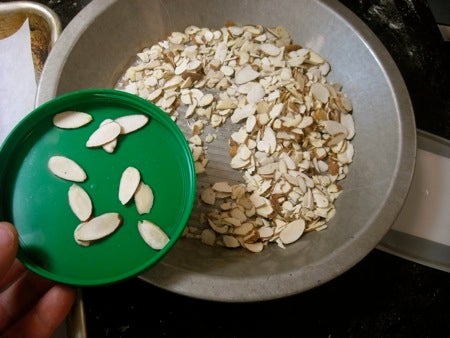
Now that the bread is all gussied up, it needs to rise for about half an hour. In our tropical kitchen, it took less time than that. The dough should look puffy, but it won't necessarily double. You'll want to get the oven heated while the dough is rising.
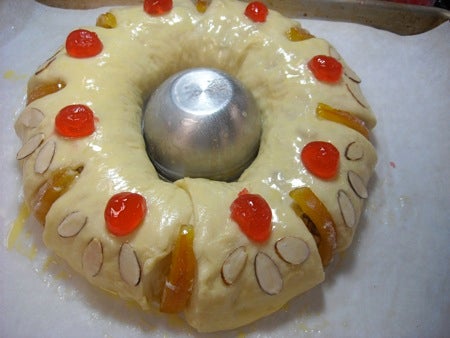
You may have to keep an eye on the peel; just push it back into place if it looks like it's loose.
Bake the bread for 25 to 30 minutes. Check it after about 15 minutes, and glue any rogue orange slices back in place with a little more egg if necessary. You can drizzle the bread with the sugar glaze in the recipe at this point or not. It gives the bread a nice, rustic look. For the beauty shot above, we just went with the egg wash and powdered the bread with some confectioners' sugar after baking.
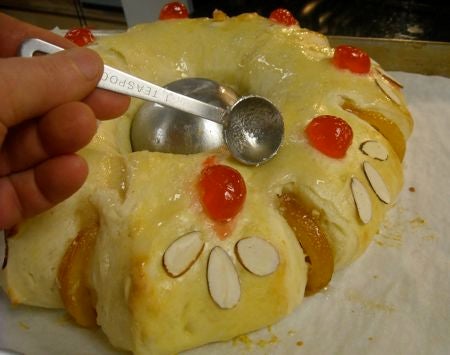
When the center of the loaf reads 19o°F when measured with an instant-read thermometer, it's done. Remove from the oven and cool on a rack.
Now you're ready for the party!
Please bake, rate and review our recipe for Three King's Cake.